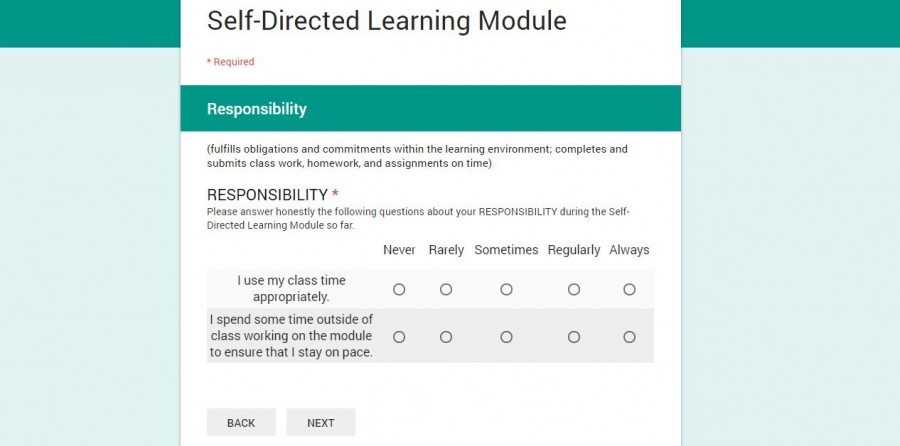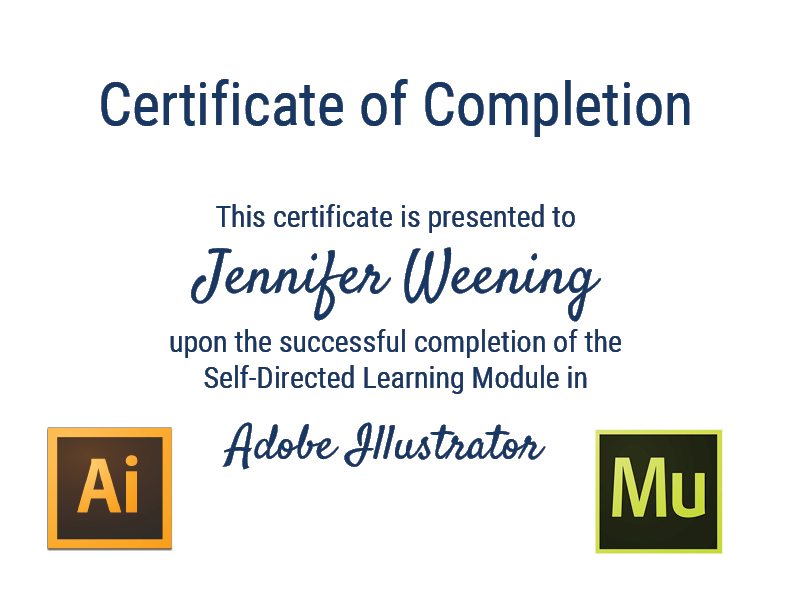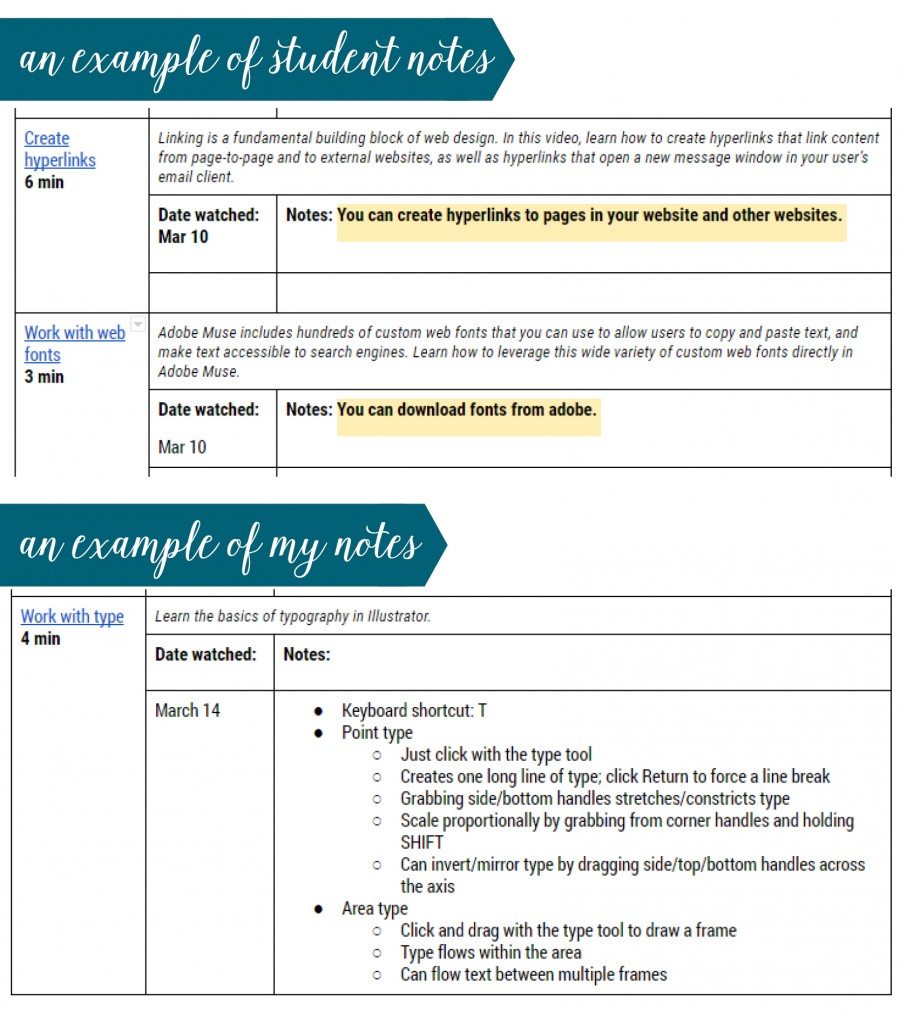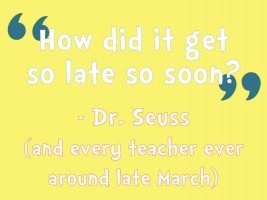Although it’s possible that I haven’t yet articulated it as such, my action plan is centred around the idea of implementing project-based and personalized learning in my Grade 11 Communications Technology class. I realized after our third face-to-face session in January that my plan of attack was a bit misguided (see “Keeping the cart behind the horse”). While revamping my entire course for this academic year would not be possible at that stage in the year, I decided to take some small steps to try out a version of personalized learning for the tail end of our unit on Graphic Design.
This year was the first time that TGJ3M was offered at CDS, and I wasn’t sure how the timing would work out. My plan was to structure it as a survey-type course, offering units in basic technology skills, photography, graphic design, video & audio production, and social media. The graphic design unit had a lot of elements, including technology instruction in Photoshop, InDesign, Illustrator, and Muse; partway through it, the plan was to introduce the ISU – a large, self-directed project where students would use some of the tools they’d learned to create a media campaign. As most teachers quickly find out, even when they’ve taught a course more than once, the school year seems to disappear before your eyes. Before you know it, exams are looming and you’re not where you’d planned and hoped to be. Comm Tech was no different for me. We’d barely scratched the surface of InDesign and we were already getting late in the year.
As frustrating as it seemed at first, it turned out that this was a gift from the Cohort21 gods, who must have known that I needed to stop thinking about my action plan in terms of next year, and do something now to implement it. I still needed to cover Muse and Illustrator, but there was no way that, in the time we had, students could learn both with enough depth to actually create something with them. Enter the personalization bit: after being introduced to the concept of the ISU, students needed to choose which program would serve them best for their end-of-year project. Muse would be for the wannabe web designers, whose media campaign would include a website, and Illustrator would be for those who wanted to create a logo as part of their campaign. We watched introductory videos for both, and then students were off to the races.
Self-Directed Learning Module
In the weeks leading up to what I came to call the Self-Directed Learning Module, I explored the extensive collections of short, simple how-to videos found on adobe.com, copying video URLs and descriptions to two separate hyperdocs (hyperdocs defined). I divided each module into three sections: Getting Started (short, basic introductory videos for the key tools for each program), Assessment for Learning (a series of videos with sample files for students to create either a logo or a website along with the videos), and Independent Learning (a section for students to seek out resources that answer their burning questions or teach them additional tools). For each video, students were to take detailed notes to look back on for reference. Each section was followed by a reflection and a learning skills self-assessment.
You can view each document here:
Adobe Illustrator Self-Directed Learning Module
Adobe Muse Self-Directed Learning Module
I knew they were long documents so I tried to make use of some of the tools in Docs to make it easier to navigate. I created bookmarks for each section and made a footer with links to each bookmark. Just recently, Docs also introduced the new “Outline” feature, which recognizes your headings and uses the grey space beside your doc to create a “smart” table of contents.
Learning skills are something that I don’t keep track of as much as I should; I had students complete a self-assessment of their learning skills three times throughout the process, and my final assessment at the conclusion of the module included my take on their work habits and learning skills. (Needless to say, students’ perceptions of how hard they’re working often differed from my own!)

The final time they completed the self-assessment, I used advanced Google Forms tools (“Go to page based on answer”) to have students provide the basic information required for a Certificate of Completion, and used the Add-on Form Publisher to automatically generate a certificate and email it to students. I liked the idea of incorporating the idea of badging into the process, and it also made it easier for me to see exactly which students had fully completed the module.

If you can’t beat ‘em, join ‘em!
One of the challenges I identified in the first step of the action plan process was that I was beginning to find it difficult to stay far enough ahead of the students to feel like the expert. Although I knew my way around Illustrator and Muse, this self-directed learning module was a perfect opportunity for me to learn along with the students. I gave myself homework, and I went through the video-watching and note-taking process just as the students did. Knowing exactly what was in the videos made me a better resource for my class – I faced some of the same difficulties they did, and my background knowledge of the software could help to fill in the blanks where the videos did not cover something. I was able to use my notes as an example for students, as I found that many of them didn’t really know how to take effective notes (I saw a lot of video summaries in place of notes).

During class, I used the time to respond to student questions and go through their documents, making comments on their notes and reflections: How could you take better notes to help you remember a process more effectively? Could practicing with the software as you watch help you to retain things better? What do you do when a video doesn’t explain something thoroughly?
Challenges
This process was certainly not all roses. Trying to keep students on track and using their class time effectively was a challenge. I had a hard time balancing the “independent work time” with my desire for students to act as resources for one another and try to problem-solve together (in my class, at least, this often quickly devolves into social time). I found it frustrating that despite writing what I thought were crystal-clear instructions, students seemed not to read them. I spent most of the class periods responding to questions whose answers were contained either within the document or within the videos or webpages. Part of the intent for this module was for students to recognize the vast network of resources available to them when they wanted to learn something, and my hope was that they would try to find an answer before turning to me. I’d love to hear some ideas about how to help students work towards greater independence and resilience in the face of setbacks. I want to create a culture of independence and problem-solving in my classroom next year – does anyone have any activities that I could use to start the year off on the right foot?
Conclusion
Despite the challenges and frustration, I believe that this was a valuable experience both for me and for my students. It was awesome to see some students embrace the freedom of working at their own pace, and I could tell that they enjoyed having the freedom to choose what to learn. I was able to spend more time supporting and facilitating individual student learning and answering questions, and less time trying to deliver content to a large group. My biggest takeaways are to keep instructions simple, and next time I might divide the three sections into three separate documents, with a clearer structure (part 1, part 2, part 3 as opposed to my three randomly-named sections). Does anyone have any other feedback or ideas for making this a more successful experience for all?
My action plan goal will remain to work towards a completely revamped course for next year with a personalized structure based on larger projects. In the meantime, however, I will take some of the lessons learned from this experience to support my students as they work on their ISUs.

Amazing, Jen! The amount of thought and work you put into this is a testament to your passion for teaching. I want to take this class now 🙂
One of the things you said that resonated with me (and there were several) was this,
“I’d love to hear some ideas about how to help students work towards greater independence and resilience in the face of setbacks. I want to create a culture of independence and problem-solving in my classroom next year – ”
I feel exactly the same way and I have read this same sentiment in many of our Cohort’s blogs as well. It’s so interesting that even though we all come from different schools, teach different grades and subjects, we so often end up with the same goals!
I too have been trying to foster independence and problem-solving in my grade 4 students. One thing that I started last year and I’ve continued this year is having a “problem of the day” out at the start of class for the kids to work on in a group (I only have 7 students). The main thing that I have changed from a typical problem is that I don’t actually ask a question. I present information (sometimes math related sometimes not) and then I ask them to write down what they notice and what they wonder. This means that no one can say I have the answer and I’m finished and it also means that the students often go far beyond what my original intent might have been. When I first started doing this I found that the students were very passive, but as they year progressed they have become much more active and collaborative, although I usually need to work with them in order to actually get any of their thinking recorded. Perhaps you can do something similar with your students?
Now that I reread my comment I realize that it might make more sense if I give an example. I will try to put one up on my blog!
Congratulations on a great start to your Action Plan!
P.S. Sorry about the long comment 😉
@mjohn –
Thank you so much for your thoughtful comment! I would love to see some examples of your “non-question-of-the-day”! Another idea I thought about but haven’t yet come up with specifics for was some sort of Google Form quiz/challenge to start the year – a scavenger hunt of sorts with pretty specific instructions. If the students were to follow the instructions to the letter, they would come up with the answer/solution/secret message, and if they missed even one, nothing would work out. The only support provided would be to continually repeat, “Are you sure you read the instructions properly?” I don’t know…. maybe it’s too mean! 🙂
I can certainly relate to the challenges you mention. I undertook a similar “Inquiry Method” in my Grade 10 Visual Art class for the 3d Design Unit. We were learning 123Ddesign together! They didn’t like to read text, or watch tutorials. They preferred to experiment and try out the various tools– until they actually had to make something specific. Then they became really frustrated. Next time I plan to have the students get used to the process first, using a shorter assignment where a bit of reading and a good tutorial or two really pays quickly and directly. I have also resolved to address “reading the assignment” as a skill more directly. Given the fact that my students are very high achievers, I was surprised to learn that they tend to skip directly to the questions and ignore the introduction and instructions. They suggested I only use bullets and point form and put the information “they need to read” in bold. Oh dear! I also discovered I have students turning on You Tube’s auto sub-titles and fast-forwarding from title to title. Perhaps some warmup self-directed learning “exercises” before the big project would wor for you too.
@rmichel –
Thanks so much for your comment! I think you’re right in that teaching process analysis needs to be one of the first things we teach if we want students to learn to be more independent and solve problems on their own. I think about how I solve a problem when I’m trying out a new technology – it seems pretty obvious to me just to find a tutorial and follow it word for word, step by step, and usually that solves my problem!
I think that we often forget that although students are considered “digital natives” (a term with which I don’t necessarily agree, but that is bandied about a lot!), there are a lot of elements of how things work that are completely lost on them! In my course, for example, it’s things like where files go when you download them, how linked vs. embedded files work, and even logging out of your personal accounts on a public computer, etc. I didn’t realize at the start of this year that I needed to teach that stuff explicitly.
You’re right in that starting with some smaller step-by-step instructional activities will probably help in developing those skills from the start of the year.
Jen
I have the exact same problems with teaching and learning with the “digital natives” –and I don’t love that term either. I realized this year I have to cover file and asset management much more explicitly and actually “teach” the importance of all the information in the dialogue boxes. I call it “clicky-click-itis” when they just click past and ignore the things that they need to review carefully. I used to be that person, so I make it a point of humour in class “Call a doctor, we’ve got a serious case of clicky-click-itis!” when they forget to browse to the file location when they are saving etc. I also assign my Grade 7’s a minds on task of calculating how many files in the school network archive, from 2005-2015, are titled “my art project” The point of the calculation isn’t the answer, of course, but its fun to watch them come up with an estimating strategies!
@jweening
It occurred to me when you said….
“I’d love to hear some ideas about how to help students work towards greater independence and resilience in the face of setbacks.”
That one reason your students found this difficult is that they have not had much practice learning like this. How many of your colleagues are teaching this way? How many times in their academic careers have they been asked to learn like this? If the students at CDS are at all like the ones at TYS then I imagine the answer is “not many”.
Jennifer – Congratulations! You are a trailblazer on a journey into the great new world that is BLENDED Learning. This world has as many opportunities as it does challenges but I think we can all agree it is worth investing time/energy into.
Many cohort members like @maragona @blng @rutheichholtz are playing in this space. It will be great to compare notes on Friday and come up with some solutions for the challenges we are all facing. The great thing about C21 is that we can do it together!
@ckirsh @lmcbeth @ddoucet
@jmedved Thank you for your comment! You’re very right in that it is not a common occurence here. It has been amazing to feel so incredibly supported throughout the entire process. Like many others have mentioned in their Action Plan blog posts, I’m not ready for it to end!
@timrollwagen @danielleganley Would love your perspective as well – See above.
@jweening
Great breakdown of your progress! I think we can all appreciate the amount of work that building a course requires and I love how you reflect on the need to work ahead to be an ‘expert’ but also realize that learning with your students is sometimes more important than being the expert. Your process has allowed for a deeper and more varied learning experience than it would have been otherwise. Self-directed and blended learning techniques engage our students more deeply – as long as they see importance and authenticity in what they are doing. How could you add a component of authentic audience to this self-directed activity? (I imagine you may have had this as part of the ISU itself.)
In regards to keeping students on track – sometimes I use ‘timed’ chunking to keep students engaged and on task – have them read and reflect (on your notes) -5 minutes, self-directed component perhaps 10-15 minutes (silent), then a 5-minute consultation with partners or you, then 10-15 minute independent. Could keep them on task and more engaged potentially. Just a thought. Also I have used DocAppender for Goal setting and reflecting which allows them to reflect on their accomplishments (much like you have done with your learning skills Form). I have had a little backlash with my PBL and personalized learning from the students but after a conversation with them, it was clear that I was one of a few teachers using a personalized approach – they just need more practice and exposure (as mentioned by @jmedved). My last big project was the best one yet – I found they had learned from the first two and needed to find their way within the blended learning realm.
I think you should chat with @marsenault on Friday – He has been doing some great stuff with blended learning techniques at LCS – He may have some insights too.
Great work – Look forward to catching up on Friday!
Tim
Wow @jweening – this is an action plan for the ages. You put so much effort into creating the experience for your students. This is great and although students don’t often jump at this, I agree with @jmedved in that students don’t have a lot of practice but many will often go for the path of least resistance – at least in my experience. Once they know the expectation and get more time with you and other teachers who are doing similar things, their resilience and independence improve.
I think you should check out @clovrics for her most recent blog post http://cohort21.com/christinelovrics/2016/04/07/personalized-learning/ it has a great visual about what Personalized Learning is.
This is an inspiring post Jen – it’s so great to see your love and dedication for learning communicated through your blog posts! Looking forward to seeing you Friday!